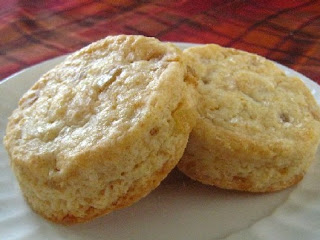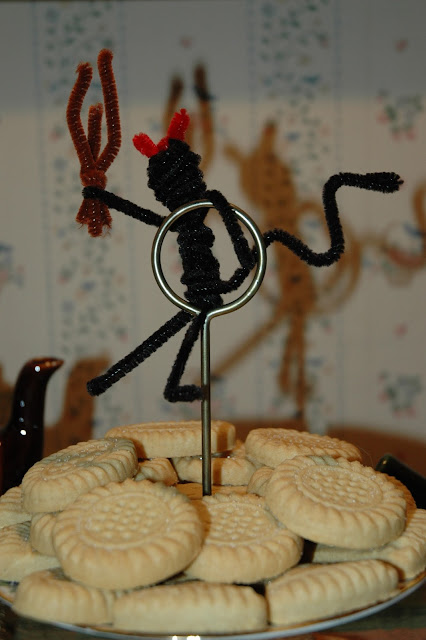At the end of each description, you will see my notes marked with **A.L.W.**. While these are ideals that are described, it is rarely seen in daily practice, especially at Bat Rabbit's.
Teapot and Pourer
The
tea pot and tea kettle are placed with the spout facing the hostess.
Tea
should be served by the host/hostess or a friend, never a servant.
Do not pour multiple
cups at a time and pass several cups at a time. Guests should take their cup
directly from the server.
**A.L.W.**
- At Bat Rabbit’s, either I serve the tea or it is self serve. And yes, I am a huge fan of Downton Abbey!
Utensils
When in doubt, use the
utensils from the outside towards the inside of the place setting.
A petit knife and fork may be used together for use on an open face sandwich,
preferably not on a closed sandwich. If savories are properly made, nothing
will be dripping or gooey. However, with the fun of non-traditional foods now
served on Afternoon Tea menus, this is not always the case. A petit knife and
fork is proper for use with one’s pastries.
Never place used utensils on a cloth or table. When not in use rest the utensil
on the right side of the corresponding plate.
Use a knife rest if it is provided.
**A.L.W.**
- You will never have to worry about a ‘petit knife and fork’ at Bat
Rabbit’s. Everyone has good ole regular
knives and forks available any time they need them.
Napkins
When excusing oneself
from the table, whether during or after a dining experience, is proper to place
one’s napkin to the left side of your place setting not in your chair. This
rule is not negotiable for the simple reason if one’s napkin were soiled it
could damage the seat covering, damage that may be either costly to repair or
irreplaceable. While the risk for soiling a cloth also exists, the cloth can be washed with relative ease.
Upon completion of a
dining experience, a napkin folded with a crease and placed to the left side of
your place setting. That indicates to
your host or hostess that you wish to be invited back.
The host or hostess
picks up his or her napkin to signal the end of the tea. He or she makes
certain all of the guests have finished before making this move.
**A.L.W.**
- I’m lucky if the napkin has not been kicked to an unrecoverable spot under
the table.
Making the Tea
Heat
the teapot with boiling water first, the pour it out, leaving an
empty hot
teapot.
Then place the tea
leaves in the teapot. The amount of tea used is dependent on the quality and
quantity of tea.
Pour
boiling water in the pot. Let it diffuse for five to eight minutes.
To serve different
"strengths" of tea from the same pot, pour half tea, half boiling
water into the cups of those who prefer their tea weak.
Note:
When tea has to stand a long time, the ideal way
is to make a strong infusion in a big kettle on the stove. Let the tea actually boil three to four
minutes on the range, then pour it through a sieve or filter into your hot
teapot. The tea will not become bitter, and it does not matter if it gets quite
cold. The boiling water poured over no
more than the tablespoonful of such tea will make the drink hot enough.
**A.L.W.**
- We serve it by the pot in one strength.
You get used to it..
Milk and Lemon
First, milk is served
with tea, not cream. Cream is too heavy and masks the taste of the tea.
But the real question
is do you add the milk first or last?
This is hotly debated in many tea circles. Here is my opinion. Milk is poured after the tea. Don't put the
milk in before the tea because then you cannot judge the strength of the tea by its color.
Where did this old milk-first tale come from?
Samuel Twining has theorized that milk first prevented early china from
cracking in reaction to the hot water.
Thinly sliced lemons
are preferable to lemon wedges. Lemon
should be placed on a dish near the milk and sugar. A lemon fork (with splayed
tines) or a similar serving utensil is provided. The tea pourer or the tea
drinker can then put a slice directly into the poured cup of tea.
Should you desire
another cup of tea, remove the slice of lemon from your cup and place it in a
waste bowl and then pour your tea. You may then add a fresh lemon slice.
Never:
- Add lemon with milk
since the lemon's citric acid will cause the proteins in the milk to curdle.
- Put the lemon slice in
the cup before pouring the tea.
- Placing a lemon slice
on the edge of the saucer in anticipation of adding it later.
- Transfer the lemon
slice from the cup of tea to the saucer.
- Use the spoon to press
the lemon slice after you place it in the cup. Untouched, the oil from the peel
and the juice from the fruit will provide the desired essence.
**A.L.W.**
- Lemon only on request and it will be in wedges and served with a regular
spoon and fork, sorry.
How to Drink Tea
Originally, all
porcelain teacups were made in China.
These small cups had no handles. In order for one not to spill the hot liquid
onto oneself, the proper way to hold the vessel was to place one's thumb at the
six o'clock position and one's index and middle fingers at the twelve o'clock
position, while gently raising one's pinkie
up for balance.
In Europe,
when the Meissen Porcelain Company, in 1710, introduced the handle to the
teacup, the tradition continued. By placing one's fingers to the front and back
of the handle, called pinching the handle with one's pinkie extended downward
or to the side, pinkie up, again
allows balance. It is not an affectation, but a graceful way to avoid spills.
Never:
- Loop your fingers
through the handle.
- Use your tea to wash
down food.
- Slurp.
- Wash food down with
your tea, always swallow completely before continuing.
- Swirl your tea as if
it were wine in a glass.
**A.L.W.**
- Just about anything goes at Bat Rabbit’s just don’t break my cups.
Stirring a cup of tea is done gently and noiselessly. Do not allow the teaspoon to touch the sides or rim of the cup. Remove the spoon and place it on the saucer behind the cup, with the handle of the spoon pointing in the same direction as the handle of the cup. Visualize the face of a clock on the saucer and properly place the handle of the cup and the handle of the spoon at four on the clock.
Never:
●
Leave a spoon upright
in the cup.
●
Place the spoon on the
saucer in front of the cup.
●
Make unnecessary noise
by touching the sides of the cup with the spoon while stirring.
●
Let the spoon drop,
after stirring the tea, with a clank onto the saucer.
**A.L.W.**
- This just makes me laugh!
How to Eat a Scone
It is improper to slice a scone horizontally to be slathered in jam and cream.
The correct manner in which one eats a scone is to place the jam and cream you will be using onto your plate. From that, apply just enough jam and cream on the scone for a single bite.
A fork may or may not be used to eat a scone. No dipping.
Never use your own utensils to dip into the jam or cream dish.
**A.L.W.**
- I never go through the trouble of slicing a scone in half. Once the scone, cream and jam have been
regulated to your plate, have at it any way you wish. Preferably, I dip my scone in the whipped
cream. I am such a rebel.
































.jpg)

















